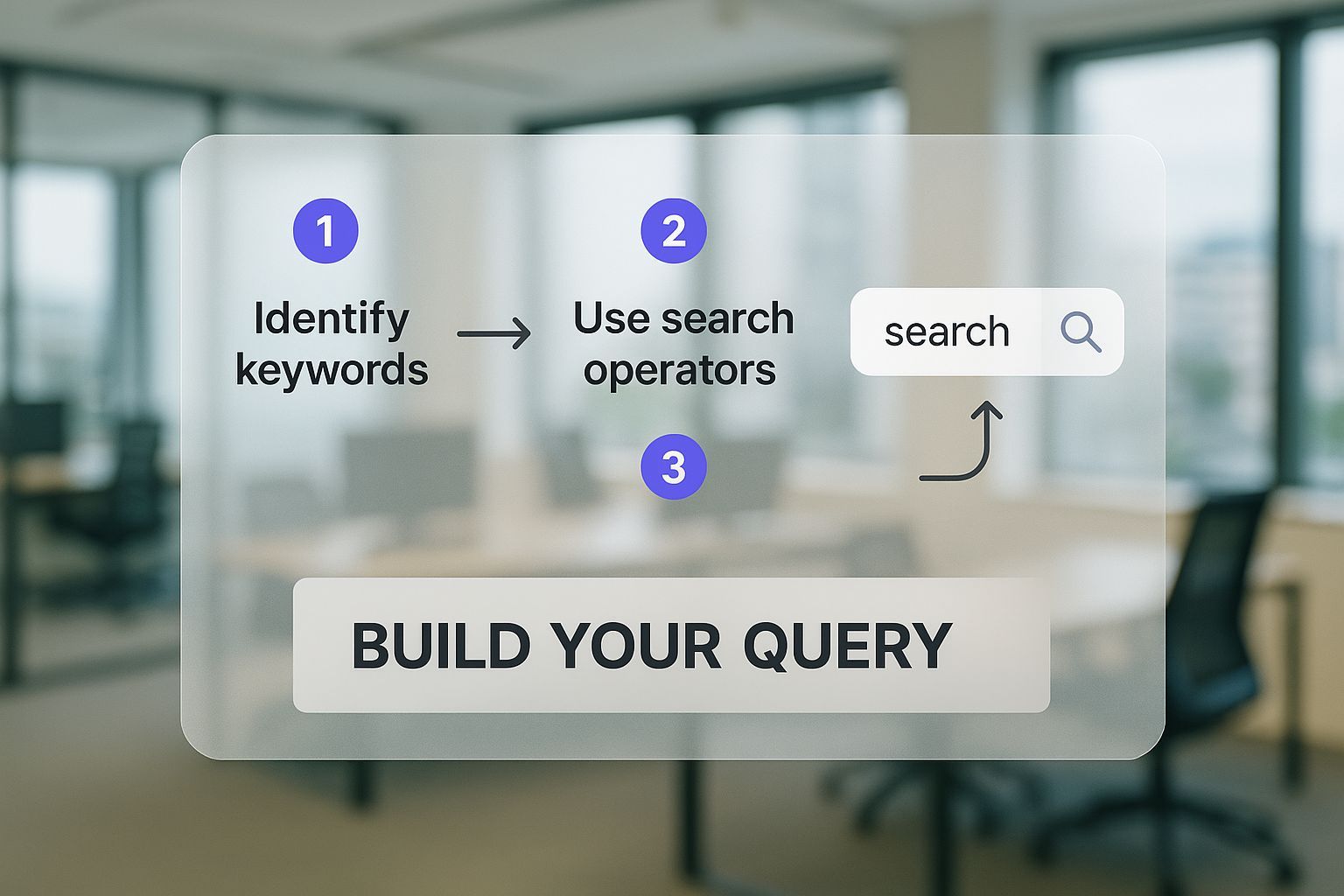To find a person using a Boolean search, you're essentially giving a search engine like Google or LinkedIn a set of precise instructions. You combine keywords with operators like AND, OR, and NOT to build highly specific queries. This method is the difference between casting a giant, messy net and using a laser-guided fishing rod to pull out exactly the candidate or lead you're looking for.
Why Boolean Search Is Your Secret Weapon in Talent Sourcing

With all the AI-powered recruiting platforms out there, it's easy to wonder if a classic technique like Boolean search still has a place. It absolutely does.
Think of it as the ultimate precision tool in your sourcing toolkit. It lets you slice through the noise of huge professional networks and search engines to find the needles in the haystack. Mastering Boolean logic gives you a serious advantage, helping you uncover hidden gems that automated tools often miss. But before you start building those power-packed search strings, you have to know who you're looking for. A little prep work in defining your target audience for LinkedIn will make your searches infinitely more effective from the get-go.
Turning Generic Searches Into Targeted Lists
Let’s walk through a real-world recruiter use case. Say you’re on the hunt for a "Senior Backend Engineer" with "Go" and "Kubernetes" skills, who must be based in "Austin."
If you just type those keywords into a search bar, you'll be drowning in thousands of irrelevant profiles. This is where a sharp Boolean string changes the game:
("Senior Backend Engineer" OR "Lead Software Engineer") AND "Go" AND "Kubernetes" AND "Austin"
That single query instantly filters the ocean of results down to a manageable, highly relevant list of candidates. You've just saved yourself hours of mind-numbing manual work. It’s about telling the search engine what to do, not just hoping it figures it out.
This kind of precision is a non-negotiable in competitive fields. I've seen it time and again: recruiters who know their way around Boolean consistently pull in better candidates than those who lean entirely on automated systems. This is especially true in tech, where the global developer shortage is predicted to hit 4.3 million, making specialized talent harder to find than ever.
If you want to find the right people with a Boolean search, you have to move beyond just typing keywords into a search bar. You need to learn the command-and-control system that powers every good search engine.
These five core operators are the bedrock of any powerful search string you'll ever build. Let's break down each one with some real-world examples, showing how you can go from a vague search to a laser-focused query in seconds.
The Five Essential Operators
You can think of these as your fundamental building blocks. Master them, and you can find just about anyone.
1. Quotation Marks ""
Use these to lock in an exact phrase. This is non-negotiable for multi-word job titles or specific skills. If you don't use them, you'll get results where the words appear separately, which is just noise.
- Before:
Project Manager(This gives you profiles with "project" and "manager" scattered anywhere.) - After:
"Project Manager"(This only returns profiles with that exact phrase.)
2. AND
The AND operator is your filter. It narrows your search by making sure every term you specify is present. It’s perfect for combining your must-have skills, location, and titles.
- Before:
"Marketing Director" SaaS London(The search engine might take some liberties here and show you results missing one of these.) - After:
"Marketing Director" AND SaaS AND London(This forces every single result to contain all three of those elements.)
3. OR
Use OR to cast a wider net. It's fantastic for catching candidates who use different but equivalent terms for the same role or skill. You'll miss out on tons of great profiles if you don't account for synonyms.
- Before:
"Account Executive"(You're completely missing anyone who calls themselves a "Business Development Representative.") - After:
("Account Executive" OR "Business Development Representative")(Now you're finding candidates with either title.)
4. NOT
The NOT operator is your clean-up tool. It strips out specific terms, instantly removing profiles you don't want to see. Think of it as a way to disqualify irrelevant results from the start.
- Before:
"Software Engineer" AND Python(This will probably pull in a lot of interns and junior-level folks.) - After:
"Software Engineer" AND Python NOT (Intern OR Junior)(By adding this, you're filtering out those entry-level candidates.)
5. Parentheses ()
Parentheses are all about controlling the order of operations, just like in a math equation. They let you group parts of your query together so you can combine multiple operators without confusing the search engine.
- Before:
"Project Manager" AND Agile OR Scrum(This is ambiguous. Is it (PM and Agile) OR Scrum? Or is it PM AND (Agile or Scrum)?) - After:
"Project Manager" AND (Agile OR Scrum)(This makes it crystal clear: find me a Project Manager who has experience with either Agile or Scrum.)
Boolean Operator Cheat Sheet for Finding People
Getting the hang of these operators takes a little practice. Here’s a quick reference table to keep handy as you start building your own search strings.
| Operator | Function | Example Search String |
|---|---|---|
| "" | Searches for the exact phrase. | "Senior Product Manager" |
| AND | Narrows the search; all terms must be present. | "Data Scientist" AND Python AND fintech |
| OR | Broadens the search; finds profiles with either term. | (UX OR "User Experience") AND (designer OR researcher) |
| NOT | Excludes specific terms from the results. | "Account Manager" NOT (assistant OR entry-level) |
| () | Groups terms together to control the search logic. | ("Software Engineer" OR "Developer") AND (Java OR Golang) |
Think of these operators as your toolkit for precision sourcing. While some modern search engines try to guess what you mean by implying AND, explicitly using these operators puts you firmly in control.
Once you’re comfortable with the basics, you can plug these concepts directly into our guide for a fast people search and start building some truly effective queries.
Building Advanced Search Strings That Actually Work
Alright, you've got the operators down. Now, let's put them into action and build an advanced string from the ground up. Theory is great, but seeing how a real-world query comes together is where the magic happens.
We'll start with a classic request that lands on every recruiter's desk sooner or later: "Find me a Marketing Director in London. They need SaaS experience, but they can't be working at any of our main competitors."
Sound familiar? Let's break it down.
Deconstructing the Search Goal
The first thing I always do is pull the request apart into its core components. This is how you translate a hiring manager's wishlist into a logical structure that a search engine can actually understand.
For this search, we have:
- Role: "Marketing Director"
- Location: "London"
- Industry/Skill: "SaaS"
- Exclusion: The competitor list
Once you have these pieces, you can start to assemble your query. This is where using parentheses to group your OR statements becomes absolutely essential. It’s how you control the search, telling the engine to handle different parts of your query in a specific order, preventing a jumbled mess of results.

Think of it like building with LEGOs. Each concept is a block, and the operators are how you connect them to build something solid.
Crafting the Final Search String
Now, let's translate those concepts into a functional string. I'm going to add a couple of common synonyms for the job title and list a few placeholder competitors to show how the exclusion works.
site:linkedin.com/in/ ("Marketing Director" OR "Head of Marketing") AND London AND SaaS NOT (CompetitorA OR CompetitorB OR CompetitorC)
This string is powerful because it’s so specific. The site:linkedin.com/in/ operator is a game-changer, forcing the search to look only at LinkedIn profiles. No more wading through company pages, articles, or other random noise.
That level of precision is critical when you remember Google handles over 9.5 million searches per minute. A well-crafted Boolean query is what separates a targeted talent search from just dumping keywords into a search bar and hoping for the best. If you're curious about the numbers, Semrush has some fascinating data on Google search statistics.
Pro Tip: My golden rule is to always put
ORstatements inside parentheses. This tells the search engine to find someone who is either a "Marketing Director" OR a "Head of Marketing" before it applies the other conditions like location and industry. Get this wrong, and your results will be all over the place.
This structured approach turns a vague request into a precision tool. You’re not just searching; you’re commanding the search engine to be your personal sourcing assistant, saving you hours of tedious, manual filtering.
The Manual Grind After a Successful Search
You've done it. After tweaking and perfecting that Boolean string, you’ve hit search and are staring at a page full of perfect-fit candidates or leads. It's a great feeling, but what comes next? For many recruiters and sales pros, this is where the real work begins—the slow, manual grind of data collection.
What comes next is a familiar, soul-crushing ritual. You start opening profile after profile in new tabs, quickly creating a browser maze that’s impossible to navigate. Then comes the mind-numbing copy-and-paste marathon—names, titles, and companies, one by one, into a fresh spreadsheet. Each new row feels like a small win, but it’s a slow, painful process.
The Hidden Costs of Manual Data Entry
This manual workflow isn't just slow; it's quietly bleeding your resources. The whole process is a breeding ground for human error, from simple typos to pasting the right information into the wrong column.
Suddenly, your pristine list is full of problems:
- Data Entry Errors: A single misplaced letter in a name or email can make a lead completely unreachable. We've all been there.
- Inconsistent Formatting: Different team members might enter locations or titles in their own way, making your data a nightmare to filter and analyze later on.
- Wasted Hours: Every minute you spend on this kind of admin is a minute you’re not spending on high-value work, like actually engaging with candidates or talking to prospects.
This manual grind is the hidden bottleneck in the sourcing process. You’ve used a precision tool to find a person with a Boolean search, only to follow it up with a blunt, inefficient method of data collection. It completely undermines the speed and accuracy you worked so hard to achieve.
The Smart Solution: One-Click Profile Extraction with ProfileSpider

So you've run your Boolean search and found a page packed with perfect-fit profiles. The old way of doing things would be to buckle in for a long session of copy-pasting. That's a serious time sink and a major drag on productivity.
Now, let's look at the modern, no-code alternative. Imagine capturing all that rich data from every single profile on the page with a single click.
With a tool like ProfileSpider, that’s exactly what happens. It turns hours of tedious clicking and copying into a one-click workflow. It’s the bridge between finding the right people and actually building a usable, organized list—giving you back your day for high-value work like candidate outreach and closing deals.
From Search to Spreadsheet in Seconds
The real magic is how seamlessly ProfileSpider moves you from discovery to action. You're no longer drowning in browser tabs and messy spreadsheets; instead, you can keep your focus on strategy.
ProfileSpider’s AI-powered extraction engine is designed to work on any website with profile information, from LinkedIn and professional directories to social media platforms. It intelligently scans the page and pulls key data from every profile it finds:
- Names and current job titles
- Company information
- Contact details like emails and phone numbers
- Links to social media and professional sites
After identifying promising leads with Boolean search, the subsequent manual grind of data extraction can be significantly reduced. To further streamline this process and truly create a smart solution, consider how you can automate repetitive tasks and reclaim your time.
When you pair a precision search with an instant data scraper like ProfileSpider, you've essentially built your own high-efficiency sourcing machine. The AI ensures the data is accurate, wiping out the costly typos and errors that always creep in with manual collection. Because all data is stored locally in your browser, you maintain complete privacy and data control.
This one-click approach transforms a powerful search into an organized, exportable list ready for your CRM or ATS, letting you get back to what actually matters: connecting with the right people.
Still Have Questions About Boolean Search?
Even after you've mastered the basics, a few common questions tend to pop up. When you're in the trenches sourcing candidates or leads, these are the ones I hear most often from recruiters and sales pros.
Can I Use the Same Boolean String on Google and LinkedIn?
Not quite. While the core logic of AND, OR, and NOT is universal, the exact way you write them changes from platform to platform.
Think of it like speaking different dialects of the same language. Google, for instance, uses a minus sign (-) to exclude a term (the NOT operator), while LinkedIn uses the actual word NOT. These little syntax differences matter. It's always a good idea to double-check the advanced search guide for whatever platform you're on to make sure your query works as intended.
My Search Is Returning Zero Results. What Gives?
If you're getting nothing back, your search string is almost certainly too restrictive. It’s a classic case of trying to be too perfect right out of the gate.
The first thing I do is start stripping it down. Remove the most niche terms first, and definitely get rid of any NOT operators for now. Another great move is to broaden your scope by adding more synonyms with the OR operator. For example, instead of just searching for "Account Executive", try ("Account Executive" OR "Sales Development Representative"). Loosen the reins a bit, see what comes back, and then you can start narrowing it down again.
Is It Legal to Scrape Profiles I Find This Way?
This is a big one, and rightly so. Generally speaking, sourcing information that's publicly available is fine. The crucial part isn't finding the data—it's what you do with it afterward.
How you collect, store, and ultimately use that information is what falls under regulations like GDPR. You have to be responsible. For a much more thorough breakdown of the rules of the road, I highly recommend reading this piece on whether website scraping is legal. It gives you the full context you need to gather data ethically and compliantly.




